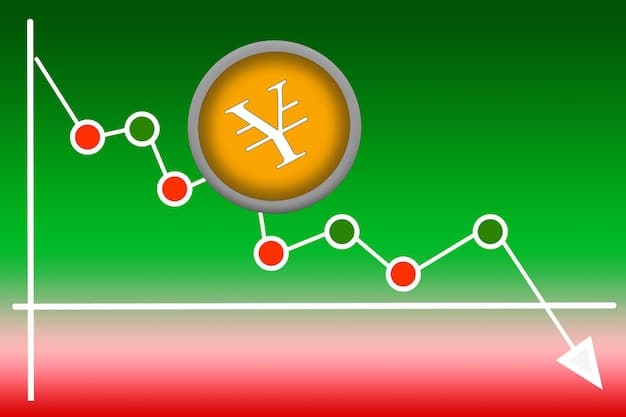Is Crypto Staking Still Profitable in 2025? A US Investor’s Guide

In 2025, staking cryptocurrency remains a potentially profitable venture for US investors, although profitability hinges on factors like chosen cryptocurrency, staking platform, lock-up periods, and the investor’s risk tolerance amidst evolving market conditions.
Navigating the world of cryptocurrency investments can be complex, especially when considering strategies like staking. So, is staking cryptocurrency still profitable? A data-driven analysis for US investors in 2025 requires a deep dive into current market trends, regulatory landscapes, and the specific mechanics of various staking platforms.
Understanding Cryptocurrency Staking in 2025
Cryptocurrency staking involves holding and “locking up” a specific amount of cryptocurrency in a wallet or on a platform to support the operation of a blockchain network. In return for this service, stakers receive rewards, typically in the form of additional units of the same cryptocurrency.
The profitability of staking is influenced by various factors, which we will explore in detail. Let’s begin by defining what crypto staking really entails in today’s financial landscape.
How Staking Works
Staking is similar to earning interest on a savings account, but instead of depositing money in a bank, you are contributing your crypto holdings to a blockchain network. This helps the network maintain its security and validate transactions.
The mechanics of staking vary depending on the specific cryptocurrency. Proof-of-Stake (PoS) cryptocurrencies use staking to select validators who are responsible for confirming new blocks of transactions. Now, let’s see an overview in list format:
- Locking Tokens: Staking requires locking up a certain amount of cryptocurrency tokens.
- Validator Selection: PoS protocols select validators based on the amount of staked tokens.
- Reward Distribution: Validators and stakers receive rewards for their participation.
Cryptocurrency staking is constantly evolving, with new platforms and staking models emerging regularly. Staying informed about these developments is crucial for making sound investment decisions.
Assessing Profitability: Key Metrics and Data

Determining whether staking is profitable requires analyzing key metrics such as annual percentage yield (APY), inflation rates, and the potential for price appreciation or depreciation of the staked cryptocurrency.
Let’s explore these metrics further, taking into account the current market conditions and projections for 2025. The return on investment is essential for any investor.
Annual Percentage Yield (APY)
APY represents the return earned on staked cryptocurrency over a year, taking into account the effects of compounding. Higher APYs generally indicate greater potential profitability, but also might indicate higher risk to investors.
It’s important to note that APYs can vary significantly between different cryptocurrencies and staking platforms. Now, let’s see the APY considerations:
Inflation and Tokenomics
While a high APY may seem attractive, it’s crucial to consider the inflation rate of the cryptocurrency. If the inflation rate is higher than the APY, the value of your holdings may actually decrease over time. Tokenomics plays an important role here.
- Token Supply: Understand the total supply and distribution of the cryptocurrency.
- Inflation Rate: Compare the inflation rate to the staking APY.
- Token Utility: Assess the real-world use cases and adoption potential of the token.
Evaluating these metrics in tandem provides a more comprehensive view of the potential profitability associated with staking a particular cryptocurrency.
Inflation is a factor that should not be overlooked, as it can directly impact the real value of your staking rewards.
Risks and Challenges of Cryptocurrency Staking for US Investors
While staking offers the potential for passive income, it also involves several risks and challenges that US investors should be aware of, including market volatility, lock-up periods, and regulatory uncertainties.
Let’s examine the risks involved in cryptocurrency staking and the measures investors can take to mitigate them. Investors need to protect their assets to the maximum possible.

Market Volatility
Cryptocurrency prices are notoriously volatile, and the value of staked tokens can fluctuate dramatically. If the price of a cryptocurrency drops significantly, the staking rewards may not be enough to offset the losses.
Market volatility can significantly impact the overall profitability of staking, especially for cryptocurrencies with high price swings. In this regard, investors need to be very careful.
Regulatory Uncertainties in the US
The regulatory landscape for cryptocurrencies in the US is still evolving, and there is uncertainty about how staking will be treated from a legal and tax perspective. New regulations could potentially impact the profitability of staking.
Being informed about regulatory developments and seeking professional advice can help mitigate these risks. US regulators are very active in the crypto space.
- Tax Implications: Understand how staking rewards are taxed in the US.
- Compliance: Ensure that the staking platform complies with US regulations.
- Legal Advice: Seek legal advice to navigate the regulatory complexities.
While regulatory uncertainty poses a risk, staying informed and taking proactive measures can help US investors navigate this challenge.
Choosing the Right Cryptocurrency and Platform
Selecting the right cryptocurrency and staking platform is crucial for maximizing profitability and minimizing risk. Factors to consider include the cryptocurrency’s market capitalization, staking APY, consensus mechanism, and the platform’s security measures and user interface.
Doing thorough research and due diligence will improve your chances of success. What should be taken into account for the selection process?
Due Diligence and Research
Before staking any cryptocurrency, it’s essential to conduct thorough research and due diligence. Evaluate the cryptocurrency’s fundamentals, team, technology, and community support. Look for projects with a proven track record and strong fundamentals.
Due diligence is paramount. Now, let’s see tips for US investors choosing their PoS.
Staking Platform Security and Reputation
The staking platform you choose should have robust security measures in place to protect your funds. Look for platforms that have a strong track record of security and a good reputation within the community. Also, don’t forget to check the interface!
- Security Audits: Check if the platform has undergone security audits by reputable firms.
- Two-Factor Authentication: Enable two-factor authentication (2FA) for added security.
- Community Reviews: Read reviews and testimonials from other users.
Choosing reputable and secured staking platforms will greatly minimize security risks and improve the overall staking experience.
Staking Strategies for US Investors in 2025
Developing a well-defined staking strategy can help US investors optimize their returns and manage risks effectively. Strategies include diversifying across multiple cryptocurrencies, reinvesting rewards, and considering the lock-up periods.
Let’s explore some proven staking strategies that US investors can implement to achieve their financial goals. What are realistic goals to pursue?
Diversification
Diversifying your staking portfolio across multiple cryptocurrencies can help reduce risk. By spreading your holdings across different assets, you can mitigate the impact of any single cryptocurrency performing poorly.
Diversification should be part of your investment strategy, especially if you want to minimize your risks.
Reinvesting Rewards
Reinvesting staking rewards can help accelerate your returns through the power of compounding. By reinvesting your rewards, you can earn even more rewards on your increased holdings.
Reinvesting your rewards is a simple way to grow your staking portfolio, but you should always consider the fees and other costs that may be associated with this strategy.
- Compounding Interest: Take advantage of compounding to grow your staking portfolio.
- Automated Reinvestment: Use platforms that offer automated reinvestment options.
- Tax Implications: Be aware of the tax implications of reinvesting rewards.
These are two popular tools for your strategy: diversification and reinvesting rewards. Now, let’s see other strategies.
The Future of Cryptocurrency Staking
The future of cryptocurrency staking is likely to be shaped by technological advancements, regulatory developments, and the increasing adoption of decentralized finance (DeFi). New staking models, such as liquid staking, are emerging to address some of the challenges associated with traditional staking.
What major trends will impact the profitability and accessibility of staking in the years to come?
Liquid Staking
Liquid staking allows stakers to access the liquidity of their staked assets by receiving a token representing their staked position. This token can be used in other DeFi applications, providing additional opportunities for yield and flexibility.
Liquid staking is one answer to the lack of liquidity, and can greatly improve accessibility. Stay tuned on further developments!
Institutional Adoption
As institutional investors become more involved in the cryptocurrency market, their participation in staking is likely to increase. This could lead to greater liquidity, stability, and innovation in the staking ecosystem.
- Increased Liquidity: Institutional participation can improve market liquidity.
- Greater Stability: Institutional investors may bring more stability.
- More Innovation: Their involvement may foster innovation in the staking space.
The future is still uncertain, but is possible to pinpoint a few trends. Now, let’s see the table summary.
| Key Point | Brief Description |
|---|---|
| 💰 APY & Inflation | Evaluate APY against token inflation for real profitability. |
| ⚠️ Risks | Market volatility and regulatory uncertainty are key risks. |
| ✔️ Due Diligence | Research crypto fundamentals and platform security. |
| 📊 Strategy | Diversify and reinvest rewards for growth. |
FAQ
▼
Cryptocurrency staking involves holding and locking up a certain amount of cryptocurrency to support a blockchain network. In return, stakers receive rewards, similar to earning interest.
▼
Staking profitability is determined by several factors, including the cryptocurrency’s APY, inflation, and the price appreciation potential. Also, risks can impact the profitability.
▼
The risks of staking include market volatility, lock-up periods, and regulatory uncertainty. US investors should be careful about these risks and protect their assets.
▼
US investors can mitigate risks by diversifying staking portfolios, doing due diligence on crypto fundamentals, and staying informed about regulatory developments. Check the project’s background.
▼
Liquid staking allows stakers to access liquidity of their staked assets by receiving a token representing their position. This token can be used in DeFi applications, increasing flexibility.
Conclusion
In conclusion, is staking cryptocurrency still profitable? A data-driven analysis for US investors in 2025 suggests that staking can still be a viable option, but only with careful consideration of the associated risks and challenges. By adopting a well-defined strategy, conducting thorough research, and staying informed about regulatory developments, US investors can enhance their chances of success in the dynamic world of cryptocurrency staking.





